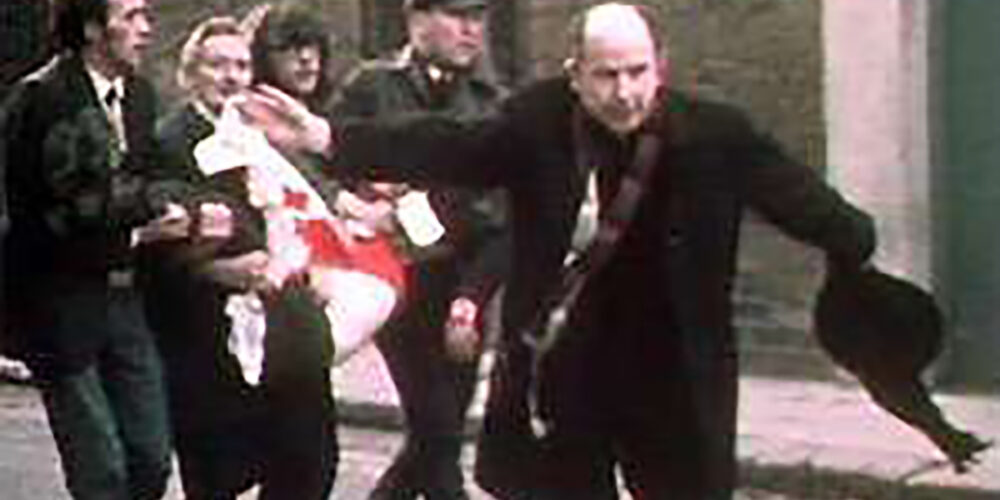“I recommend people not to employ Roman Catholics, who are 99 per cent disloyal.”—Basil Brooke, minister of agriculture, later prime minister of Northern Ireland
May this year is the centenary of the establishment of the Stormont regime and the institutionalising of violent division, mass repression, mainly against the Catholic minority, and the use of some some of the most repressive legislation in the world. This was aimed at suppressing the nationalist minority and at intimidating and coercing members of the working class from a unionist political background into identifying with and supporting unionist employers and big farmers, and acquiescing in suppression and discrimination against the nationalist minority.
This was all done to secure the needs and interests of the unionist capitalist class, in alliance with and subservient to the superior needs and interests of British imperialism.
The birth of the Orange state was marked by widespread pogroms and violence against the minority community.
The establishment of the Stormont regime was the strategy adopted by the British, using their willing allies in the Unionist capitalist class as the best means of thwarting the struggle for national independence being carried on by the Irish people, which the British were determined to prevent.
The Government of Ireland Act, implemented from 23 December 1920, was an essential building-block for preventing independence and fracturing the forces engaged in the struggle of the people of Ireland for our freedom. It also ensured that the economic and political interests of Britain’s closest ally in Ireland, unionism, were secured for the empire. Before the passing of the Government of Ireland Act it needed to have a manageable territory that unionism could politically hold and secure and also that would provide the British with the pretence that they were simply acknowledging the real situation in Ireland.
Between the second and third reading of the act in 1919 and 1920 reactionary unionist violence in working-class communities was sanctioned and organised by the Unionist leaders. During these pogroms the Unionist employers directed the mobs’ attacks and drove out militant trade unionists from the shipyards and engineering factories, thereby killing two birds with the one stone.
These pogroms resulted in more than 23,000 people being driven from their homes in Belfast and nearly 500 killed, more than 90 per cent of them civilians and a significant majority Catholics, while Catholics barely made up a quarter of the population of Belfast. Over a period of two years it was estimated that more than 50,000 people fled the Six Counties, that is, one in ten of the nationalist population.
This became a tried and trusted method of instilling fear and compliance in what would become regular and periodic pogroms in the hundred-year existence of the Orange state, also securing an economy based on mass discrimination, with employment opportunities limited to those most loyal and with membership of the Orange Order and the various unionist paramilitary police forces securing a worker’s employment and future.
These sectarian economic practices would last for fifty years, before the mass mobilisation behind the Northern Ireland Civil Rights Association. The mass struggle for civil rights shattered the power of unionism and forced the British to step in again to protect their imperial interests. The role of the British in this violence was further illustrated when the imperial state recruited the pogromists into the Ulster Special Constabulary.
The Government of Ireland Act succeeded in securing British interests and preventing Irish self-determination. The British ruling class, with the Unionists playing a subordinate role, partitioned Ireland according to the needs and interests of imperialism and its profoundly reactionary agenda.
It was the British who peddled the lie that they were only facilitating self-determination for unionism. Then, as now, any solution has to be in line with imperial needs and interests. The British state has always shown disdain and mistrust towards the Irish people. The century of Stormont has been a century of cynical manipulation and violence, a century of evasion and suppression.
The British have been successful in constructing and maintaining the illusion that they have no strategic interests in Ireland, merely keeping two “tribes” apart and protecting the “self-determination” of the unionist population. The British state successfully sold this illusion to the Irish establishment, which is all too willing to obey their orders and to protect its own class interest. Even some former opponents of British rule have bought in to this great illusionist trick. As James Connolly put it so well, “Ruling by fooling is a great British art, with some great Irish fools to practise on.”
Partition failed the economic and political needs of the people of Ireland when it was imposed a century ago, and continues to fail the people’s interests today, while the beneficiaries have been the British and their parasitic Irish and Unionist elite allies.
Partition has weakened and divided the forces for national independence. The Government of Ireland Act consolidated the influence and control by the settler community in the Six Counties, who rejected and opposed the civic Irish nation promoted by Wolfe Tone and the United Irishmen with the institutionalising of a sectarian statelet—a state and its oppressive laws and apparatus envied by the South African apartheid regime.
Partition ensured a century of reaction in our divided country and has allowed two parasitic and dependent ruling groups to govern two failed political and economic entities, operated in alliance with the imperial powers of Britain, the European Union, and the United States. It is they who now decide the destiny of our people.






